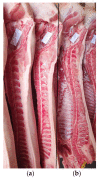Effects of Lactobionic Acid on Pig Growth Performance and Chemical Composition of Pork
- PMID: 35565564
- PMCID: PMC9104116
- DOI: 10.3390/ani12091138
Effects of Lactobionic Acid on Pig Growth Performance and Chemical Composition of Pork
Abstract
Lactobionic acid is an innovative product obtained in the fermentation process of cheese or curd whey, and it has several beneficial properties. Therefore, it may have potential application in animal feeding. Currently, lactobionic acid is not widely used yet in feeding farm animals. Therefore, the aim of our study was to evaluate the effect of lactobionic acid (LBA) on pig growth performance and pork quality. Two groups of pigs (control and trial, 26 piglets each) were completed. The control group received compound feed, whereas the trial group's feed was supplemented with LBA (0.17 kg per 100 kg of feed). Carcass weight and meat pH were determined. The subcutaneous fat layer S (mm) was measured. Lean meat content was determined using the SEUROP classification. Amino acids and fatty acids in pork were evaluated. The addition of LBA to pig feed significantly increased the live weight gain and slaughter yield of pigs, but the samples had a slightly thicker backfat layer. Results obtained showed higher concentration of amino acids in the trial group but slightly lower pork fat quality in the same group. Lactobionic acid has the potential for applications in pig feeding.
Keywords: amino acids; carcass quality; fatty acids; live weight; pigs; slaughter yield.
Conflict of interest statement
The authors declare no conflict of interest.
Figures
Similar articles
-
Effects of dietary vitamin E and fat supplementation in growing-finishing swine fed to a heavy slaughter weight of 150 kg: I. Growth performance, lean growth, organ size, carcass characteristics, primal cuts, and pork quality.J Anim Sci. 2022 Apr 1;100(4):skac081. doi: 10.1093/jas/skac081. J Anim Sci. 2022. PMID: 35289901 Free PMC article.
-
Feeding strategy in organic pig farming as a lever to improve various quality dimensions of pork.Animal. 2024 Jul;18(7):101190. doi: 10.1016/j.animal.2024.101190. Epub 2024 May 16. Animal. 2024. PMID: 38870587
-
Increasing dietary inclusions of camelina cake fed to pigs from weaning to slaughter: Safety, growth performance, carcass traits, and n-3 enrichment of pork.J Anim Sci. 2017 Jul;95(7):2952-2967. doi: 10.2527/jas.2016.1308. J Anim Sci. 2017. PMID: 28727106
-
Effects of feeding and rearing systems on growth, carcass composition and meat quality in pigs.Animal. 2008 Oct;2(10):1548-58. doi: 10.1017/S1751731108002796. Animal. 2008. PMID: 22443914
-
A review of heavy weight market pigs: status of knowledge and future needs assessment.Transl Anim Sci. 2017 Feb 1;1(1):1-15. doi: 10.2527/tas2016.0004. eCollection 2017 Feb. Transl Anim Sci. 2017. PMID: 32704624 Free PMC article. Review.
Cited by
-
The Impact of Biotechnologically Produced Lactobionic Acid on Laying Hens' Productivity and Egg Quality during Early Laying Period.Animals (Basel). 2024 Oct 14;14(20):2966. doi: 10.3390/ani14202966. Animals (Basel). 2024. PMID: 39457896 Free PMC article.
-
The Impact of Biotechnologically Produced Lactobionic Acid in the Diet of Lactating Dairy Cows on Their Performance and Quality Traits of Milk.Animals (Basel). 2023 Feb 23;13(5):815. doi: 10.3390/ani13050815. Animals (Basel). 2023. PMID: 36899672 Free PMC article.
-
Genome-wide association analysis explores the genetic loci of amino acid content in duck's breast muscle.BMC Genomics. 2024 May 16;25(1):486. doi: 10.1186/s12864-024-10287-1. BMC Genomics. 2024. PMID: 38755558 Free PMC article.
References
-
- Schingoethe D.J. Whey Utilization in Animal Feeding: A Summary and Evaluation. J. Dairy Sci. 1976;59:556–570. doi: 10.3168/jds.S0022-0302(76)84240-3. - DOI
Grants and funding
LinkOut - more resources
Full Text Sources


